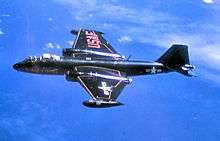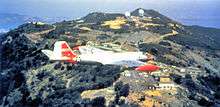List of B-57 units of the United States Air Force


The Martin B-57 Canberra was first manufactured in 1953, and the United States Air Force had accepted a total of 403 B-57s before production ended in early 1957. The last USAF B-57 was retired in 1983.
It was the last tactical bomber used by the United States Air Force, being engaged in combat operations during the Vietnam War (1963–1971). It also performed a wide variety of other missions. This list is of the units it was assigned to, missions performed, and the bases it was stationed.
Units
Tactical Bombardment
The B-57B Tactical Bomber was the replacement for the World War II B-26 Invader. Assigned to TAC, USAFE, PACAF. 202 aircraft produced. Production began in 1952, deliveries began in 1954. TAC aircraft sent to Air National Guard by 1958, being replaced by F-100 Super Sabre. USAFE aircraft withdrawn from France in 1957 by agreement with French Government.
PACAF 8th and 13th Bombardment Squadrons flew B-57B Tactical Bombers in combat during Vietnam War, 1964–1969. The B-57G modification (Tropic Moon Night Intruder, 18 B-57B aircraft modified, 1968–1969) flew in combat 1970–1972. Last aircraft retired from Air National Guard, 1974.
The B-57Cs was a limited-production dual-control trainer version of the B-57B (1954–1958). 38 produced. A small number of B-57Cs were later re-equipped and redesignated as RB-57C for service alongside RB-57A Reconnaissance aircraft as trainers when the latter were issued to ANG units.
|
|
Tactical Reconnaissance
The RB-57A was the replacement for the RB-26 night reconnaissance aircraft. 67 produced. The aircraft was filled with various cameras and was unarmed, its mission being day and night, high and low, and visual and photographic reconnaissance. It filled the photo-reconnaissance mission of the RB-26, but were not reliable and also had a high accident rate. Replaced by the RB-66B Destroyer and RF-101C Voodoo by 1958; survivors sent to the Air National Guard. Some were converted to Air Defense Command EB-57A electronic warfare aircraft to provide training for air defense radar units. By 1973, most of the surviving R/EB-57A's had been retired to AMARC at Davis Monthan AFB, Arizona. A few were converted to RB-57F strategic reconnaissance/weather reconnaissance aircraft.
Ten RB-57As were modified for high-altitude strategic reconnaissance over non-friendly areas under "Project Heartthrob". Designated RB-57A-1s, they flew high-altitude reconnaissance missions over Eastern Europe, Communist China and North Korea in the late 1950s. Two other RB-57As, designated RB-57A-2 were modified with a bulbous nose containing AN/APS-60 mapping radar and a SIGINT direction finder system in 1957 under project SARTAC.
Eight RB-57Es were modified from B-57E Target Towing aircraft and were fitted with cameras and other sensors as part of the "Patricia Lynn Project" during the Vietnam War. They were used in spotting Viet Cong river traffic at night along the Mekong Delta southeast of Saigon. In 1969/70, Patricia Lynn missions were flown into Laos and into Cambodia. The Patricia Lynn operation was terminated in mid-1971.
|
|
Strategic Reconnaissance
The RB-57D was a high-altitude strategic reconnaissance aircraft. 20 produced. Extended wing with higher thrust engine modification of B-57B, operated in lower stratosphere. Operations remain largely classified (1957–1963). Replaced by Lockheed U-2.
The RB-57F was the result of an early-1960s program to produce a virtually new high-altitude reconnaissance aircraft out of the B-57. 21 produced. Developed from some RB-57As, RB-57Bs, and RB-57Ds in 1963 with newer engines and wider wings. Used for strategic reconnaissance. Transferred to Air Weather Service as WB-57Fs, 1968
Two WB-57Fs are the only B-57 aircraft model still flyable and in service (NASA, 2011).
|
|
Weather Reconnaissance
B/RB-57C/D/E/Fs operated by the Air Weather Service. WB-57Ds used for high altitude atmospheric sampling for nuclear weapons testing/monitoring. WF-57Fs were remaining RB-57Fs re-designation after June, 1968. Used for high-altitude weather monitoring and occasionally fitted with cameras for clandestine strategic reconnaissance flights. Retired 1981.
|
|
Tow Target
Dedicated Air Defense Command target towing aircraft used for training of F-86D Sabre, F-94C Starfire, and F-89D Scorpion interceptors firing 2.75-inch Mk 4/Mk 40 Folding-Fin Aerial Rockets. 68 produced. As F-102 Delta Dagger interceptors firing heat-seeking AIM-4 Falcon air-to-air missiles became available, the target towing mission of the B-57E became obsolete, and beginning in 1960 the B-57Es were adapted to electronic countermeasures and faker target aircraft (EB-57E).
In order to cover combat losses in the Vietnam War, twelve B-57Es were reconfigured as combat-capable B-57Bs at the Martin factory in late 1965 and were deployed to Southeast Asia for combat. Six converted to RB-57E "Patricia Lynn" tactical reconnaissance aircraft during the Vietnam War. Retired 1974.
|
|
Defense Systems Evaluation
Used by Air Defense Command as simulated target aircraft for interceptors and training of ground control intercept radar units. Used re-purposed RB-57As, B-57Bs, B-57Cs, B-57E as they became available from their previous missions. Used by active duty units until 1971; Air National Guard until 1983.
|
|
Air National Guard
Operational Support
Used by Air Force Systems Command at Edwards AFB, California and Eglin AFB Florida for functional test flights and modification testing. Also for various special projects such as hurricane monitoring; Air Force Special Weapons Center; high altitude research; aircraft missile launch testing; missile guidance systems testing, FAA and NASA research projects.
|
|
References
- Mikesh, Robert C. Martin B-57 Canberra: The Complete Record.Atglen, Pennsylvania: Schiffer Publishing Ltd., 1995. ISBN 0-88740-661-0.
- Mueller, Robert. Air Force Bases Volume I: Active Air Force Bases Within the United States of America on 17 September 1982. Office of Air Force History, 1989.
- Ravenstein, Charles A. Air Force Combat Wings Lineage and Honors Histories 1947–1977. Office of Air Force History, 1984.
- Baugher, Martin B-57